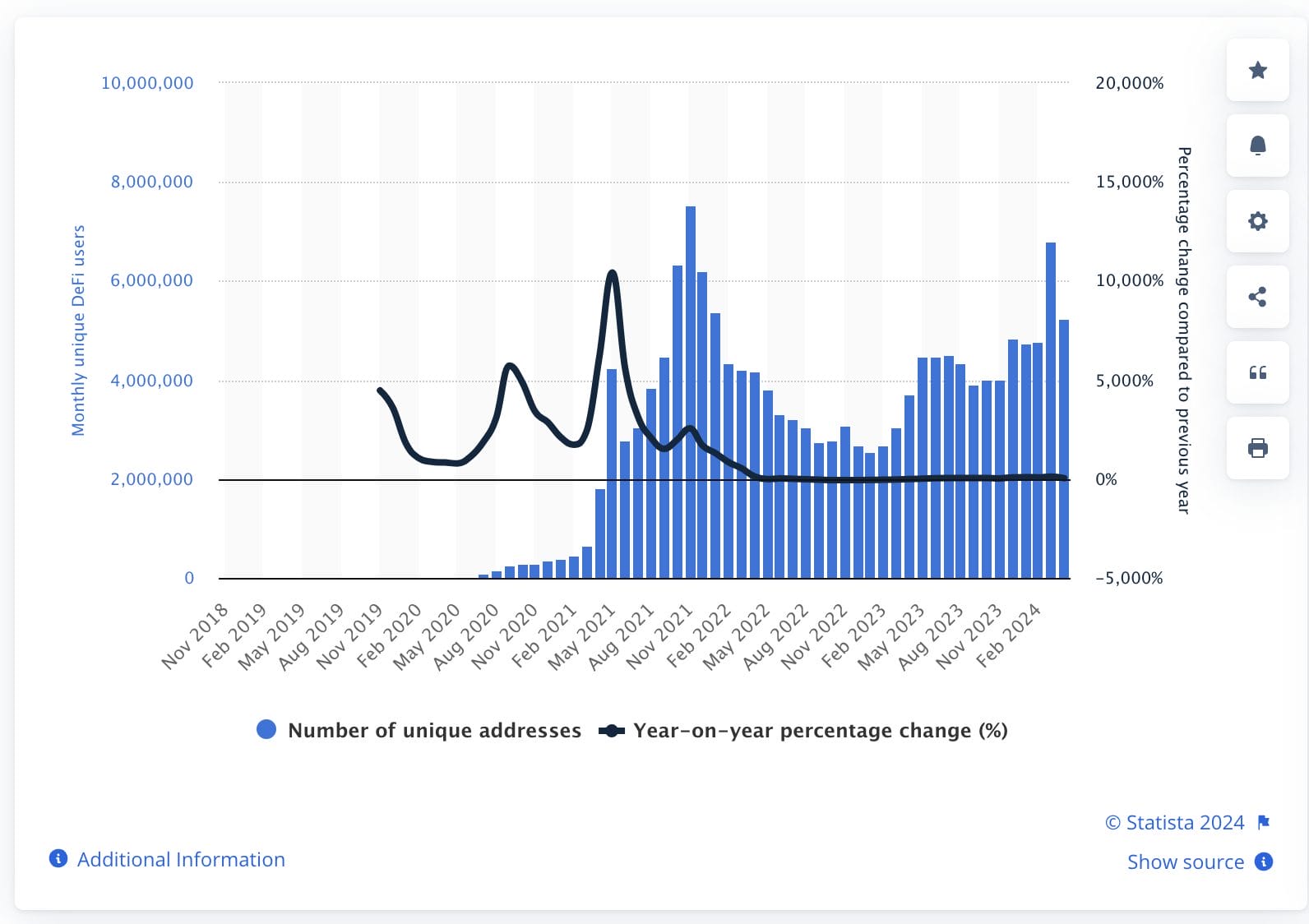Blockchain Projects Tackle DeFi’s Biggest Hurdle: Consumer Confidence

Decentralized finance (DeFi) strives to offer global access to financial products through decentralized blockchain networks.
This is achieved by removing intermediaries, reducing transaction fees, and frequently offering yield-generating opportunities for higher returns.
However, despite its potential, DeFi faces major obstacles to mainstream adoption. DeFi user numbers peaked at 7.5 million in 2021 but experienced a notable decline the following year.
 Source: Statista
Source: Statista
This downturn is further mirrored in the total value locked (TVL) within DeFi protocols, collapsing from $175 billion at the end of 2021 to a mere $50 billion by November 2023 .
Decentralized Finance Today Is Challenging and Misunderstood
The main problems hindering Decentralized Finance adoption today are a lack of accessibility and understanding.
For instance, when compared to traditional finance (TradFi), DeFi is often challenging for mainstream and crypto users alike.
Adam Simmons, CMO of Layer-1 network Radix, told Cryptonews that while the vision of DeFi is enticing, the concept around it fails to deliver.
Simmons explained that DeFi concepts – like self-custody of assets, seed phrases and security measures – have created adoption barriers for users.
“Self-custody of assets may sound great on paper — however, outside of the crypto bubble, the idea of putting large sums of money or assets into a system where a single seed phrase exclusively controls access is terrifying to most consumers,” he said.
Simmons added that if a user loses their seed phrase, all of their money or assets could quickly disappear.
In 2023 the DeFi industry witnessed substantial losses . A total loss of approximately $1.95 billion occurred last year alone .
According to a De.Fi blog post , these losses can be attributed to a continuous battle against security breaches, fraudulent activities and a bull or bear market.
“Hacks, exploits, and bad actors result in billions of dollars of assets being lost or stolen each year,” Simmons said. “In many situations, common patterns in DeFi today, such as spend approvals or blind-signing transactions, can drain all your assets, sometimes even months or years after you clicked something you shouldn’t have.”
Solving DeFi Challenges Through Transparency
Simmons acknowledges these hurdles present considerable challenges for the average consumer. Fortunately, blockchain projects are actively working to address these issues.
For example, Simmons explained that Radix is helping ensure that users can sign and approve DeFi transactions easily and confidently.
“The most common experience today is being presented with a screen that says something like ‘Confirm Transaction: 0xd12345aaa…. Approve / Decline.’ For 99.99% of the population, they are completely trusting that their wallet or dApp UI has correctly created the transaction they are expecting when they tap ‘approve,’” Simmons explained.
Simmons shared that Radix solves this problem with a feature called “transaction manifests and transaction review.” Simmons explained that this is a default function of Radix, allowing users to easily see which assets are being removed and deposited from their Radix accounts.
Another challenge the DeFi sector faces involves real-time pricing from the time between creating and signing a transaction. Crypto prices fluctuate quickly , often resulting in different prices.
Simmons pointed out that Radix has a feature called “guarantees,” which ensures that users will receive the transaction amounts expected.
“Guarantees are conceptually simple; if the transaction review on the Radix wallet shows 100 xUSDC being withdrawn from your account, and an estimated 100 XRD being deposited, the user can set a custom Guarantee in the transaction of, say, 99.5%,” Simmons said. “This means that when the transaction is signed, if the resulting transaction does not return at least 99.5 XRD, the transaction will be rejected.”
Democratizing Liquidity Access
In TradFi, liquidity refers to how easily an asset can be converted into cash without impacting its market value.
Yet this concept differs in DeFi. For instance, in DeFi liquidity refers to the ease with which tokens can be traded on a decentralized exchange (DEX) or used within a DeFi protocol.
High liquidity means that there are numerous amounts of tokens available for trading, yet this still presents challenges.
Tim Wang, COO of Elixir – a liquidity infrastructure layer – told Cryptonews that although on-chain liquidity remains at a premium, liquidity provisioning to orderbooks requires specialized knowledge.
“This inefficiency leads to exchanges having to pay exorbitant fees or tokens to attract centralized market makers to their platform,” Wang said. “This creates worse execution for traders on their platform, and general attrition of capital.”
Wang explained that Elixir sekks to improve exchange liquidity efficiency by integrating into wallets and consumer applications like Robinhood.
“The end state for Elixir is to integrate into institutional funds as sources of liquidity with yield targets that are commensurate with the risk of the ultimate end asset (e.g. Bitcoin being the lowest risk / lowest yielding) where the liquidity is being used,” he said.
Wang remarked that on the back end, Elixir’s infrastructure would help route the liquidity to the highest-yielding pairs across all exchanges that utilize the platform’s liquidity.
“Exchanges will be free to incentivize liquidity to their pairs and ‘compete’ for liquidity with other exchanges,” Wong added.
Layer-2’s Will Enable Bitcoin DeFi
Bitcoin DeFi has started gaining traction due to the emergence of Bitcoin layer-2 (L2) networks. According to Rena Shah, COO of TrustMachines – a team focused on growing the Bitcoin economy – Bitcoin DeFi is critical to the crypto sector.
She told Cryptonews that Bitcoin (BTC) is larger than all the other chains combined. “There is $1 trillion in value waiting to be unlocked through Bitcoin DeFi. It’s the biggest opportunity that will ever exist in crypto,” Shah said.
While notable, Bitcoin DeFi remains largely inaccessible. Shah pointed out that this is likely due to the fact that Bitcoin doesn’t have a virtual machine (VM) or smart contracts platform like other blockchain networks.
“Layers have to be the protocols that increase the functionality and scalability of the Bitcoin blockchain,” she said. “By moving certain functions to the L2, we’re able to work with the current functionality of the L1 without changing the core ethos of Bitcoin.”
Shah added that she hopes the recently approved Bitcoin spot ETF in the United States will drive more users to adopt Bitcoin DeFi.
In the meantime, Shah is aware that the crypto sector is still in the early days of building the infrastructure needed for Bitcoin DeFi.
Consumer DeFi Inevitable, But Will Take Time
While DeFi remains an ongoing challenge, consumers will likely be able to leverage decentralized finance concepts in the future.
“Consumer adoption of DeFi will be slow and steady,” Simmons remarked.
He added that although technical innovations go a long way to making DeFi accessible, other factors must be taken into account.
For example, Simmons pointed out that regulatory frameworks are still evolving and will necessitate many changes. “This ranges from how DeFi front-ends may operate to how those consumers on-ramp and off-ramp from crypto,” he said.
Additionally, Simmons remarked that while real-world assets (RWAs) are gaining traction , the majority of DeFi is exclusively crypto-native assets that the vast majority of consumers are not actively looking to use in their daily finances.
“Most DeFi dApps today are focused on relative niche activities for average consumers, with perhaps the exception of DEXs,” he said. “Over collateralized lending, perpetuals trading, and yield farming may be popular with sophisticated users looking to maximize profits, but general consumers typically engage with financial products like payments, deposits, direct debits, etc.”
Challenges aside however, Simmons believes that DeFi adoption is inevitable. “From a pragmatic standpoint, DeFi helps the global financial system allocate capital more efficiently based on opportunity and risk,” he said. “In much the same way that the internet made data freely flow across a global, unified network, bringing huge new opportunities with it, DeFi does the same for assets. We’re just in the early 2000’s era.”
Disclaimer: The content of this article solely reflects the author's opinion and does not represent the platform in any capacity. This article is not intended to serve as a reference for making investment decisions.
You may also like
SEC Crypto Task Force to Hold Roundtable as Agency Reevaluates Enforcement Approach

Roam (ROAM): The Future of Global Connectivity

[Initial Listing] Bitget Will List Mint Blockchain (MINT) in the Innovation and Public Chain Zone.
Bitget x MINT Carnival: Grab a share of 5,380,000 MINT!